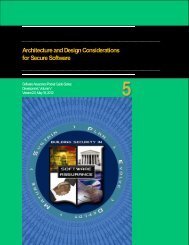Secure Coding SwA Pocket Guide - Build Security In - US-CERT
Secure Coding SwA Pocket Guide - Build Security In - US-CERT
Secure Coding SwA Pocket Guide - Build Security In - US-CERT
Create successful ePaper yourself
Turn your PDF publications into a flip-book with our unique Google optimized e-Paper software.
Many C/C++ compilers can detect inaccurate format strings. For example, the Gnu Compiler Collection supports a C extensionthat can be used to mark functions that may contain inaccurate format strings, and the /GS compiler switch in Microsoft’s VisualC++ .NET can be used to flag buffer overflows in runtime code.For C, consider using the as-if infinitely ranged (AIR) integer model, which provides a largely automated mechanism foreliminating integer overflow and truncation and other integral exceptional conditions [Plum & Keaton 2010]. The AIR integermodel either produces a value equivalent to that obtained using infinitely ranged integers or results in a runtime-constraintviolation.While type and format string checks are useful for detecting simple faults, they are not extensive or sophisticated enough todetect complex vulnerabilities. Some compile-time tools perform taint analysis, which flags input data as “tainted” and ensuresthat all such data is validated before allowing it to be used in vulnerable functions. An example is Flayer, an open source taintanalysis logic and wrapper [flayer 2009]. This is also built into the Perl language. Other compilers include more extensive logic toperform full program verification and prove complex security properties based on formal specifications. Program verificationcompilers are most often used to detect flaws and “dangerous” constructs in C and C++ programs and libraries, includingconstructs that leave the program vulnerable to format string attacks and buffer overflows.Additional protections that may require compile-time support include compiler randomization of variables and code positions inmemory, particularly the randomization of the location of loaded libraries and assembler preprocessors to reduce C and C++program susceptibility to stack overflows. This often requires both compiler and runtime support.Resources» flayer: Taint analysis and flow alteration tool. 7 October 2009. Google Project Hosting. 27 July 2010.» GNAT Pro High-<strong>In</strong>tegrity Family. AdaCore. July 2010.» “Eliminating Buffer Overflows, Using the Compiler or a Standalone Tool,” 75-81. Plum, Thomas andDavid M. Keaton. Proceedings of the Workshop on Software <strong>Security</strong> Assurance Tools, Techniques,and Metrics. Long Beach, CA, November 2005. U.S. National <strong>In</strong>stitute of Standards and Technology(NIST), 2005.» “Static Code Analysis in VS2010”, Gousset, Mickey. Visual Studio Magazine, 25 March 2010.» "Static Analysis for <strong>Security</strong>," Chess, Brian and Gary. IEEE <strong>Security</strong> and Privacy, vol. 2, no. 6, pp. 76-79, Nov. 2004, doi:10.1109/MSP.2004.111Avoid <strong>Security</strong> Conflicts Arising Between Native andNon-Native, Passive and Dynamic CodeApplications often rely on code that was written either in another programming language or after the application was originallydeveloped. For example, some non-native, Java applications may rely on native C code to interface directly with hardware. Thisis a potential vulnerability because an attacker may be able to perform a buffer overflow attack against the native code, even ifthe Java portions are not vulnerable.To give another example, an Asynchronous Java and eXtensible Markup Language (AJAX) application may supply dynamicallygenerated JavaScript to the web browser to perform an operation. As a result, the dynamically generated code could have beendeveloped after the original application. This could lead to invalid input to the AJAX application if the dynamically generated codeis making different assumptions about the environment and state of the application.<strong>In</strong> both cases, it is imperative that applications treat native and dynamic code as potentially un-trusted entities and thatdevelopers perform validation on data going to, or coming from, the un-trusted code.Software Assurance <strong>Pocket</strong> <strong>Guide</strong> Series:Development Volume VI – Version 2.0, , May 18, 2012<strong>Secure</strong> <strong>Coding</strong>11
















